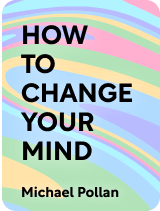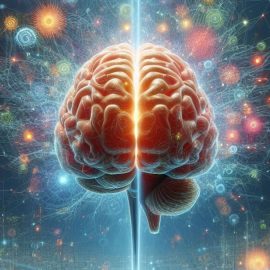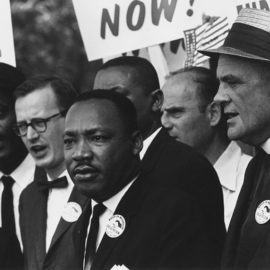

This article is an excerpt from the Shortform book guide to "How to Change Your Mind" by Michael Pollan. Shortform has the world's best summaries and analyses of books you should be reading.
Like this article? Sign up for a free trial here.
What does the history of LSD look like? What role does LSD play in modern Western culture?
In How to Change Your Mind, Michael Pollan looks at the complicated role of psychedelics—most importantly LSD and psilocybin—in modern Western culture. As we’ll see, this is a history fraught with tension between experimenters and authority figures, a conflict between freedom and control.
Find out more about the history of LSD, dating back to 1938.
The Accidental Invention of LSD
Pollan explains that the history of LSD begins in a Swiss laboratory in 1938. A chemist named Albert Hofman was working on medical research that involved creating synthetic compounds from ergot, a toxic fungus that grows on grains. He identified an alkaloid in ergot called lysergic acid and began to create derivatives of it, looking for medical treatments for respiratory and circulatory ailments. The 25th derivative would be a revolutionary invention called lysergic acid diethylamide-25 (LSD-25).
Five years into his experimentation with these compounds, Hofman accidentally absorbed a minute amount of LSD-25 through his skin. He had the world’s first acid trip that afternoon, which he documented in detail, and this discovery had some extraordinary effects on the world.
| LSD: Hofman’s Problem Child Hofman’s famous first trip occurred on April 19, 1943. He was so astounded by that first experience that he decided to experiment more with this mysterious compound. He did this by intentionally dosing himself and by testing it on animals. This substance would change the trajectory of Hofman’s life and career, and he went on to take LSD hundreds of times. Hofman became an enthusiastic environmentalist, and he argued that LSD could repair humans’ dysfunctional relationship with nature by awakening a renewed sense of oneness and connection with the natural world. On his 100th birthday in 2006, he described LSD as “a tool to turn us into what we are supposed to be.” But he also recognized the dangers of the drug—his 1980 memoir is titled “LSD — My Problem Child.” In it, he warns against the careless recreational use of this substance, advocating for a more carefully ritualized use, in the way that indigenous cultures treat psychedelics as a ritual sacrament. Hofman died in 2008 at the age of 102. Because his first trip began as he was bicycling home from his lab, April 19 is now celebrated annually by psychedelic enthusiasts and referred to as “Bicycle Day.” |
As medical researchers learned about LSD in the 1940s and 50s, some believed the LSD experience sounded like it mimicked psychosis. This prompted psychiatrists to question whether mental illness might have a biochemical basis, whereas it had previously been understood to be purely psychological. Pollan explains that the effect this shift in thinking had on psychiatric research was revolutionary. Some psychiatrists even undertook personal experimentation with LSD, thinking it would allow them to better understand the experience of their psychotic patients and improve their ability to treat them. By the 1950s, research testing LSD on psychiatric patients was ongoing in medical centers and universities in Europe, America, and Canada.
Because researchers initially used LSD to intentionally induce temporary psychosis, they were surprised when, after more widespread experimentation, most subjects reported positive experiences. While some subjects reported paranoia and anxiety, many described feelings of transcendence, oneness with the world, heightened sensory experiences, and profound new philosophical or spiritual understandings. This led researchers to consider much broader applications for the drug, and it was eventually tested for treatment of a variety of conditions, such as depression, anxiety, obsessive compulsive disorder, and addiction (most notably alcoholism).
(Shortform note: The co-founder of Alcoholics Anonymous (AA), Bill Wilson, believed that LSD could help alcoholics recover from addiction, and he proposed using it in the program in the 1950s. Wilson had taken LSD as a subject in psychiatric experiments and had found relief from his debilitating depression. He began to consider how the spiritual awakening experienced by many users could be helpful for alcoholics in the 12-step program, specifically by fostering a connection with a higher power—an essential step in the program. Other members of the organization opposed Wilson’s proposition, however, and in 1958 he stepped down from the governing body because of it.)
Moral Panic Leads to the Banning of Psychedelics
Pollan tells us that the socio-cultural effects of psychedelic use—particularly LSD—in the counterculture scene were eventually perceived to be too disruptive to society, so the US government began to crack down on it. He says that President Richard Nixon once referred to Leary as “the most dangerous man in America.”
By the mid-1960s, propaganda focusing on the dangers of psychedelics—which Pollan says were mostly exaggerated or entirely fictitious—began to circulate heavily in the media, and a moral panic ensued. University researchers were ordered to cease experimentation with psychedelics in 1966, and by the end of the decade, the substances were made federally illegal. The Controlled Substances Act, passed in 1970, classified LSD and psilocybin as Schedule I substances, which means they’re deemed to have high potential for abuse and no recognized medical value, despite evidence to the contrary. They remain classified as such today.
Pollan explains that some researchers he spoke with pointed out that this moral panic was not unlike the earlier colonial powers’ suppression of the use of psychedelics by indigenous cultures. Many believe that power figures object to a population’s exposure to these mystical states because it undermines hierarchical structures—in other words, it makes people harder to control.
While Leary and others like him can be partially blamed for the widespread banning of psychedelics in both academia and society as a whole, Pollan points out that their haphazard and unruly approach to experimentation was probably necessary. This was uncharted territory, and they could only have learned how context-dependent psychedelic experiences are by trying out different methods. They ultimately learned that psychedelic-assisted therapy works best in a controlled and guided setting, and the current phase of research is taking those findings seriously and implementing them.

———End of Preview———
Like what you just read? Read the rest of the world's best book summary and analysis of Michael Pollan's "How to Change Your Mind" at Shortform.
Here's what you'll find in our full How to Change Your Mind summary:
- The long and complex history of humans' relationship with psychedelics
- Psychedelics' potential use for mental health treatment today
- Why there are so many cultural and legal issues surrounding psychedelics






